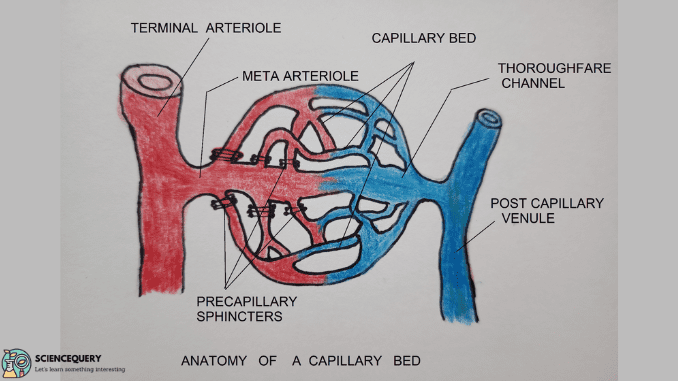
Capillaries
Introduction
Capillaries are the smallest and the most numerous of the blood vessels. They connect arteries and veins. The primary function is to exchange nutrients, gases, and wastes between tissues and organs.
Definition
Capillaries are microscopic vessels that carry blood from arterioles to small veins or venules.
Functions
1. Diffusion
- Substances like oxygen, carbon dioxide, nutrients, and wastes enter and leave by simple diffusion.
- Oxygen and nutrients are present in higher concentrations in blood. So they diffuse down the concentration gradient into the interstitial fluid and body cells.
- Carbon dioxide and body waste released by cells are in high concentration. So they diffuse into the blood.
- Substances like glucose and amino acids being water soluble pass capillary walls through fenestrations and intercellular clefts.
2. Pinocytosis
- Lipid insoluble molecules get enclosed in tiny pinocytic vesicles.
- These vesicles enter endothelial cells by endocytosis.
- Next, they move across the cell and exit on the other side by exocytosis.
3. Filteration and resorption
- Fluids and solutes from blood capillaries move into interstitial fluid through filtration across a pressure gradient.
- Fluids and solutes from interstitial fluid move into capillaries through pressure gradient by reabsorption.
Significance
- Form a part of circulation called the microcirculation, ensuring blood flow from arteriole to venule.
- Also play an important role in the exchange of nutrients, gases and other wastes between blood and cells and tissues.
- Capillary beds also regulate blood pressure and flow of blood to the organs and tissues when needed .
(The precapillary sphincters constrict to shunt blood away from capillary beds to vascular shunt).
- It enables new blood cells to enter the blood stream.
- Capillaries present in the renal system enables filtration and elimination of nitrogenous wastes from the body.
Types
Of Three types :
1. Sinusoidal capillary
- Possess large intercellular clefts. These are the most permeable.
- Blood flow is sluggish, allowing time for modification of large molecules and blood cells that pass between blood and tissue.
- Contains macrophages in the lining to capture and destroy foreign bodies entering the system.
- It is found in red bone marrow, spleen, and liver.
2. Continuous capillary
- Have small intercellular clefts. They are the least permeable.
- Continuous capillaries in the brain are unique. Tight junctions are present between endothelial cells in blood brain barrier.
- It contains cells called pericytes. These cells control endothelial cell growth and perform phagocytosis.
- Present in muscles, skin, and lungs.
3. Fenestrated capillary
- These have medium intercellular clefts. The presence of fenestration pores is seen in between endothelial cells.
- They allow for the movement of plasma proteins and other solutes.
- These capillaries occur in the kidneys and glands.
Structure
- Are microscopic. It’s 8 to 10 micrometers in size.
- Arteries branch further to smaller vessels –terminal arterioles and metarterioles. Metarterioles are a single layer of smooth muscle surrounding endothelial cells. These lead to capillary beds.
- Capillary beds are interwoven networks of capillaries known as true capillaries.
- At the junction of metarterioles and capillaries are present precapillary sphincters that control the blood flow.
- Capillary beds unite in post-capillary venules via thoroughfare channels. Post-capillary venules merge into larger veins.
- The wall of capillaries is formed of a single layer of endothelial cells (tunica intima) and basement membrane.
- The diameter(lumen) is so small that only a single RBC can pass through at a time.
- Pericytes (spider-shaped stem cells ) help stabilize capillary walls. It controls permeability and plays a role in vessel repair.
Diseases associated with capillaries
- Systemic capillary leak syndrome: It is caused by substances in the blood that damage capillary walls.
- Capillary hemangioma: It is a benign tumor in capillaries in infants.
- Microangiopathy: It is a condition where the capillary walls thicken. It leads to leaking and bleeding. It primarily results when blood sugar levels are high.
- Arteriovenous malformation syndrome: It occurs when there are no capillaries between arterioles and venules. The arteries and veins form abnormal tangles. Most common in the brain and spinal cord.
- Petecjiae: It is caused when capillaries break open. Blood leaks into the skin. It is caused due to infections or side effect of drugs.
Q&A
1. What is capillaries and its function?
They are the smallest blood vessels of the circulatory system. It helps in the exchange of gases, nutrients, and wastes between blood tissues, and cells of the body.
2. What do the capillaries do in the respiratory system?
Capillaries surrounding the alveoli (unit of lungs) help in the oxygenation of the deoxygenated blood of the body.
3. What are the three types of capillaries?
The three types of capillaries are: continuous, fenestrated, and sinusoidal.
4. What is the function of a capillary bed?
Capillary beds supply oxygen, and nutrients to the cells and tissues and return carbon dioxide, and wastes to blood.
Summary
- Capillaries are microscopic blood vessels. It carries blood from arterioles to venules. The walls consist of thin endothelial cells with a basement membrane. These lie in contact with the body tissues.
- They arises from arterioles( branches of big arteries) to form capillary beds. Capillary beds unite to form post-capillary venules.
- The junction of arteriole and capillaries are guarded by precapillary sphincters. It regulates blood flow to the tissues and cells as required.
- Capillaries supply food and oxygen to tissue cells and remove wastes.
- There are three types of capillaries: continuous, fenestrated, and sinusoidal.
- Dysfunction of the capillaries forms conditions like Systemic capillary leak syndrome, petechiae, etc.
References:
Human Anatomy by Saladin, Kenneth S.
Written By: Ahana Mitra
